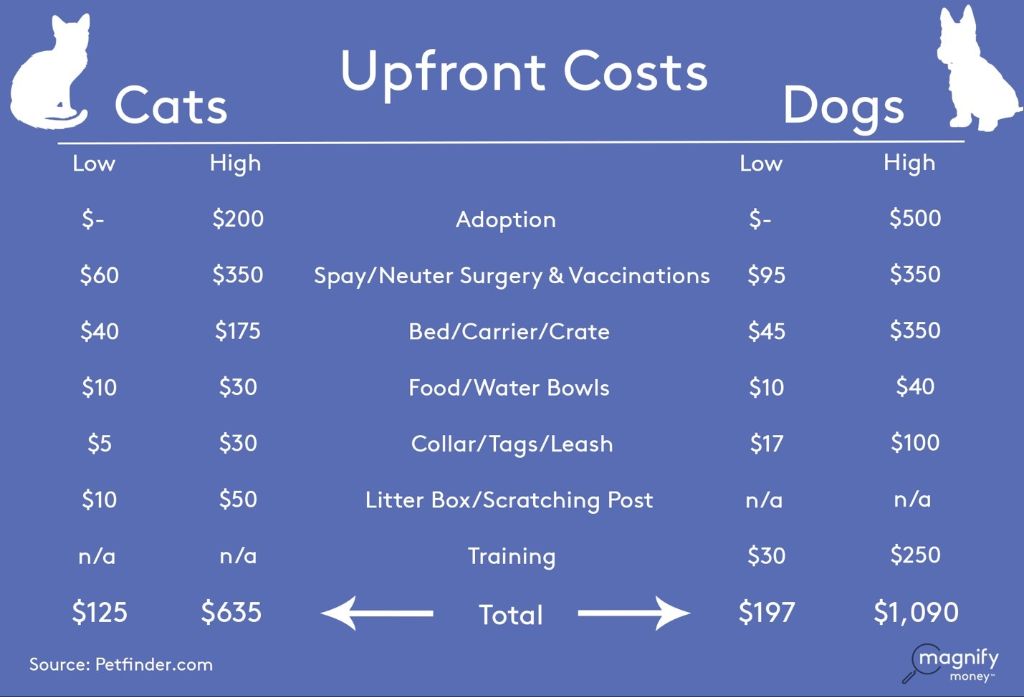Introduction
This article provides a comprehensive comparison of cats and dogs as pets. It examines their history as companion animals, popularity, care requirements, behavior, costs, health considerations, and more. The goal is to analyze the pros and cons of cats versus dogs objectively, so readers can decide which better fits their lifestyle. Key factors like indoor versus outdoor suitability, lifespan, trainability, and personality traits are covered. By the end, readers will have the information needed to determine if a cat or dog is the right pet for their family.
History as Pets
The domestication of dogs and cats occurred at different points in history. According to research from the University of Iowa, the first animals to be domesticated as pets were dogs. Dogs began to be domesticated by humans as early as the 14th to 16th centuries, during the late Middle Ages and early Renaissance period in Europe.[1] During this time, dogs started to take on roles as companions and helpers for hunting and guarding. On the other hand, cats were not domesticated until later, mainly as useful predators to control vermin. An article from University College London explains that dogs branched off as a separate family from wolves about 7.8 million years ago, while cats diverged from a common cat ancestor 10.3 million years ago.[2] So dogs were the first pets, with a closer evolutionary relationship to humans.
Popularity
The most popular pet globally is the dog, with approximately 25% of households owning at least one dog. This equates to over 470 million households worldwide owning dogs as pets. Cats come in second, with around 220 million households owning at least one cat. (“Most Popular Pets by Country 2023”)
In the United States, freshwater fish are the most popular pet overall, with 142 million households owning them. Cats come in second at 88.3 million households, followed closely by dogs at 74.8 million. Other popular US pets are small animals like hamsters and rabbits, and birds. (“Pets, Pets Everywhere: The World’s Most Popular Pets”)
The popularity of pets varies by country. For example, cats are more popular than dogs in many European countries like France and Poland. In parts of Asia such as China and India, small pets like fish, birds, and turtles are common. South American and African countries tend to prefer more exotic pets like reptiles and rodents.
Care Requirements
Cats and dogs have different care requirements when it comes to food, grooming, and health needs.
For food, dogs generally need a more protein-rich diet than cats. According to PetPlace1, the average cost of feeding a medium-sized dog is $235-$370 per year, whereas for a cat it is $200-$340. Cats are obligate carnivores and need diets high in protein and fat, while dogs are more omnivorous. Dogs will also need more food overall than cats based on their size and activity level.

In terms of grooming, most cats are very self-sufficient and require only occasional brushing to remove loose hair. Dogs require more regular brushing and bathing – weekly or monthly for short-haired breeds, and daily for long-haired breeds. Regular nail trims are also important for dogs. Professional grooming costs can range from $30-$80 per visit for a dog depending on coat condition and services needed.
For health, annual vet visits are recommended for both cats and dogs for vaccinations and checkups. However, according to Withy Grove Vets2 dogs are more prone to injuries, parasites, and illnesses that may require additional vet care over their lifetime compared to cats. Dogs also require heartworm prevention medication not needed by cats. Overall, dogs tend to have higher health care costs than cats.
Behavior
There are several key differences when it comes to the behavior and personality traits of cats and dogs. As hunters, cats are more independent, cautious, and territorial. Dogs are more social, outgoing, and eager to please. Cats can be aloof and unpredictable, while dogs tend to be loyal and affectionate pack animals.
In terms of trainability, dogs are generally much easier to train due to their innate desire to follow commands and please their owners. Cats are less motivated by praise or food rewards. However, cats can be trained through positive reinforcement to do simple tricks and behaviors. Dogs are able to learn a wide variety of complex behaviors and tasks.
When it comes to activity levels, dogs require much more exercise and stimulation. Breeds like Labrador Retrievers and Border Collies are extremely high energy and need vigorous daily exercise. Cats are often content with shorter play sessions and entertaining themselves. However, breeds such as Bengals and Savannahs are more active and curious.
Overall, dogs display more outward affection, exuberance, and trainability. Cats tend to be calmer yet more cunning and opportunistic. Understand their inherent traits allows owners to provide proper care and training for happy and well-adjusted pets. While challenging at times, appreciating both their similarities and differences makes owning cats and dogs incredibly rewarding.
Indoor vs Outdoor
When deciding whether to keep your cat indoors or let them roam outdoors, there are several factors to consider regarding their ideal living environment. Indoor cats live longer on average, with a life expectancy of 10-15 years versus just 2-5 years for outdoor cats, according to the UC Davis School of Veterinary Medicine (https://www.dailypaws.com/cats-kittens/cat-safety-tips/indoor-vs-outdoor-cats). Keeping cats indoors protects them from common outdoor hazards like cars, territorial stray cats, diseases spread by other cats, and attacks from dogs or wildlife. Indoor cats are also less likely to get lost, stolen or injured in fights.
However, some argue that keeping cats confined indoors prevents them from expressing their natural hunting behaviors. Providing adequate exercise and enrichment activities indoors is key to keeping indoor cats happy. Cat trees, toys, scratching posts, food puzzles, and regular playtime can fulfill an indoor cat’s needs for physical activity, mental stimulation and companionship (https://www.americanhumane.org/fact-sheet/indoor-cats-vs-outdoor-cats/). Ultimately, each cat owner must weigh the risks and benefits of indoor versus outdoor access to determine the ideal environment for their unique cat.
Costs
When it comes to upfront costs, dogs tend to be more expensive than cats. Buying a puppy from a breeder can cost anywhere from $300 to over $1,500 depending on the breed, while adopting a dog from a shelter typically ranges from $50 to $300. Cats are generally cheaper, with kittens from breeders priced from $500 to $1,500 and adoption fees at shelters averaging $50 to $100 (“The True Cost of Owning a Dog or Cat,” https://www.credit.com/blog/cost-of-owning-a-dog-or-cat/).

In terms of ongoing expenses, both cats and dogs require food, supplies, veterinary care, grooming, boarding and other recurring costs. For food, expect to budget $200 to $400 annually for a cat and $300 to $900 for a medium-sized dog. Litter, litter boxes, scratching posts and toys will cost around $200 per year for a cat. Annual medical expenses average $460 for a dog and $230 for a cat, while boarding and grooming can add several hundred dollars more each year. Overall, the first year cost of owning a dog ranges from $1,314 for a small mixed breed to $1,843 for a medium purebred. For cats, the first year typically costs between $835 to $1,174 (“Cats vs. Dogs – Which pet is more affordable?,” https://www.wkyc.com/article/money/magnify-money/cats-vs-dogs-which-pet-is-more-affordable/95-315679128).
Allergies
Allergies are a major concern for many pet owners. While there is no such thing as a truly “hypoallergenic” dog or cat, some breeds tend to produce less dander and be better tolerated by allergy sufferers. According to Filtrete, cat allergies are about twice as common as dog allergies. This is likely due to the fact that cats tend to groom themselves more often, spreading allergenic proteins called Fel d 1 through their saliva and skin.
For dogs, breeds like Poodles and Schnauzers tend to be better for allergy sufferers, as they have minimal shedding and produce less dander. Short-haired dogs also tend to release less dander than long-haired breeds. Regular bathing and brushing can help reduce dander levels for any dog. For cats, the Siberian, Oriental Shorthair, and Devon Rex tend to produce lower amounts of the Fel d 1 protein.

While no breed is 100% hypoallergenic, taking steps to reduce dander along with vacuuming, air filtration, and washing hands after contact can help minimize allergy symptoms. Those with severe cat allergies may find it easier to own a dog, but each person’s sensitivity levels vary.
Lifespan
Both cats and dogs have varying lifespans depending on breed, lifestyle, and other factors. However, on average, cats tend to have longer lifespans than dogs.
The average lifespan for domestic cats ranges from 12-18 years, with some cats living into their early 20s. According to one source, the average lifespan for domestic dogs is 10-13 years. Larger dog breeds tend to have shorter lifespans, while smaller dogs live longer on average.
The oldest known domestic cat lived to 38 years old, while the oldest known dog lived to 30 years old. Well cared for indoor cats and smaller dog breeds given proper veterinary care are more likely to live to the upper end of their lifespan range.
There are several theories as to why cats tend to outlive dogs. Some factors are believed to include differences in metabolism, ability to utilize protein and calories efficiently, exposure to infectious disease, and anatomical differences. Additionally, neutered cats and dogs tend to live longer than unneutered animals.
Conclusion
In summary, there are several key differences between cats and dogs that make each better suited for different households and lifestyles. Dogs tend to be more energetic, social, and require more attention and exercise. They thrive on interaction with their owners and love outdoor activity. Cats, on the other hand, are more independent and lower maintenance. They are often content being left alone for periods of time and do not require as much active time or attention from their owners.
For these reasons, dogs may be better pets for active households with time to dedicate to daily walks, playtime, and interaction. Dogs are often viewed as better for families with children since they love to play and interact. Cats may be better suited for quieter homes with owners who work longer hours, travel frequently, or are often away. Their self-sufficiency allows them to be left alone more readily.
In the end, there are good reasons for choosing either a dog or cat. The lifestyle fit, time commitment, and personal preferences of the owner should drive the decision more than notions that one is universally better than the other. With proper care and commitment, both cats and dogs can make excellent companion pets in the right households.

